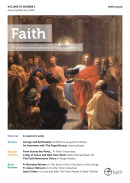Book Review: The true spirit of the liturgy
Review by Father Nicholas Palmer OCSO
The Seven Gifts of the Spirit of the Liturgy is a centennial appraisal of Romano Guardini’s The Spirit of the Liturgy, a founding text of the liturgical movement which greatly influenced Vatican II.
A useful introduction summarises the chapters, before Bishop Arthur Serratelli discusses Chapter 1, ‘The Prayer of the Liturgy’ (pp. 27 ff.). He opens with the context of Modernism and individualism in prayer and gives Guardini’s response that the liturgy is a communal act of worship of the whole Church. Private devotions are a necessary complement, but must be guided by the liturgy’s laws. Unlike devotions, the liturgy does not focus on one truth to the exclusion of others – for example, God’s mercy over His justice – enhancing its universality. The content of liturgical prayer is the Word Himself, who becomes contemporary with us. These ideas about truth and the Word are highpoints for me.
Individualistic and social personalities
Cassian Folsom then surveys Chapter 2, ‘The Fellowship of the Liturgy’ (pp. 39 ff.). The liturgy is celebrated by the entire body of the faithful, across time and space, including the saints in heaven. Three personality types are given: two individualistic – objective and subjective – and one social; and the asceticism, sacrifice and personal action necessary for the integration into the liturgical community of each. I found Folsom’s description here clearer than Guardini’s. Those of the social temperament must realise the union of members is not accomplished from one person to another, but by their joint aim and spiritual resting place, God. I found this insightful. Subjectivism must be avoided and the objective meaning of the liturgy recovered, so that it has significance for everyone.
The broad and the narrow
Michon M. Matthiesen discusses Chapter 3, next: ‘The Style of the Liturgy’ (pp. 55 ff.). He gives two definitions of style: broad and narrow. The broad sense is seen when any “vital” principle finds its authentic, true expression, and is of wide importance and accessibility. An example is St Francis of Assisi with his naked dependence on God and compassion for the weak and poor. This has broad appeal and is formative. A narrow sense illuminates the Church’s liturgy, manifesting a simplification of the multiplicity of life, by underscoring inner coherence, order, and lawfulness. In terms of liturgical music, Guardini gives Gregorian chant as representative of this narrow sense. Matthiesen says it simplifies the singularity and complexity of other musical modalities. (But did it also contribute to the wall of incomprehension in Guardini’s day? This is discussed in Chapter 2, p. 52.)
Dividers and Blenders
David W. Fagerberg commemorates Chapter 4, next: ‘The Symbolism of the Liturgy’ (p. 71 ff.). Guardini goes beyond the category of profound thinker in seeking not simply to balance but to integrate two or more extreme positions at a time, says Fagerberg. This chapter discusses those who see body and soul as sharply defined and those who see them as amalgamated, called by Fagerberg Dividers and Blenders, respectively. Dividers isolate the spiritual plane and so find liturgy challenging. Blenders also find it difficult with their lack of objectiveness regarding defined formulas. In seeking to integrate them, Guardini brings us to the concept of symbolism. Liturgical symbols are elementary signs to which human nature responds, for example, signing oneself with the cross. Both ego types must cooperate: Dividers admitting the relationship between the spiritual and physical and making use of symbolism; Blenders binding the vague and ephemeral elements into clear cut forms.
The child of God in joyful adoration
Father Daniel Cardo reviews Chapter 5, ‘The Playfulness of the Liturgy’ next (pp. 89 ff.). He points to two of Guardini’s figures: Ezekiel’s vision of Cherubim in ‘purposeless’ contemplation; and Wisdom rejoicing before God, in Proverbs. Two images are said to reflect this `sublime uselessness’: the play of the child and the creation of the artist. The liturgy, however, offers something greater: the possibility of becoming, by grace, not a simple child at play, but a child of God living in joyful adoration of its Father. I like this message a lot. Cardo introduces two paths for appreciating the rite: the priest’s formation to Christ the High Priest, and mystagogical formation of the faithful through reflections on homilies by the Fathers. There is a need to trust both the rite and the capacity of the faithful, who, even in our time of relativism and confusion, still desire the truth that the liturgy brings.
Nerveless asceticism
Bishop James D. Conley discusses Guardini’s Chapter 6, ‘The Seriousness of the Liturgy’ next (pp. 103 ff.). Conley echoes Guardini’s point that the liturgy is chiefly regarded from the standpoint of salvation. The liturgy is, therefore, serious work, and he says it must be beautiful to serve its purpose. I don’t think Guardini says liturgy needs to be beautiful exactly; it just will be if it reflects truth. Conley quotes Guardini, that pride of place, though not of worth, goes not to beauty but truth. He also mentions the danger of beauty being placed before truth or being treated separately, which would lead to ‘nerveless aestheticism.’ He says such aestheticism has hindered Sacrosanctum Concilium’s reform, shrouding the mysteries of the Mass in banality, making Guardini’s work ever-relevant.
Logos vs. Ethos
Our final chapter in Guardini, ‘The Primacy of Logos over Ethos’ (pp. 115 ff.), is reviewed by Father Emery de Gaal. He asks: what is more fundamental to Christian life: knowledge and truth (Logos) or will and action (Ethos)? He says many regret that the Catholic liturgy is unrelated to current affairs in daily life. Liturgy, however, resists being translated into action but is principally occupied in forming the Christian ‘temper.’ He says in the Christian Middle Ages, primacy was given to the Logos over the Ethos, bringing much cohesion and solidarity. But as science ascended from the Renaissance, the focus shifted from Logos to Ethos, from truth to action, our age becoming `a powerful, restlessly productive, labouring community.’ Contemplation of God in love is no longer deemed foundational to minds formed in primarily practical matters. Guardini called for a return to a Christ-(Logos)centred understanding of reality, particularly in the liturgy. The will is blind without Logos, though action is not inferior to contemplation. It is a question of emphasis. The personal Logos, Jesus Christ, gives a harmony that does not eliminate Ethos but provides its sure grounding. In the liturgy, the Logos has been assigned its fitting precedence over the will, states Guardini, because man’s purpose is contemplation, adoration, and glorification of divine truth.
Future liturgical renewal
We end the book with an ‘Afterword’ by Susan Benofy (pp.133ff.) which tells of the influence of Guardini’s book through Vatican II to our present day. Pope Emeritus Benedict says it inaugurated the Liturgical Movement in Germany which in turn influenced Sacrosanctum Concilium. He says two contrary interpretations of Vatican II have emerged since, however, one invoking a “spirit of the council” divorced from its texts; the second silently bearing fruit, in continuity with what came before. In the former, a new individualistic spirit had placed the people, not God, at the centre of the liturgy. In contrast, Pope John XXIII had hoped the council would imbue with Christian light and penetrate with fervent spiritual energy not only the depths of souls but all human activities. Benofy suggests that re-examining postconciliar liturgical practices, guided by Guardini and Sacrosanctum Concilium, would allow today’s Catholic to become imbued with the true spirit of the liturgy, as the council urged. Then a beautiful liturgy would bring congregational unity in their joint resting place, God, and transform human activities.
In conclusion, the book is an excellent way of refocusing our attention on Guardini’s foundational work, adding fresh insights and surveying contemporary problems, which can only benefit future liturgical renewal.
Father Nicholas Palmer is the novice master of Mount Saint Bernard Abbey, Leicestershire.






